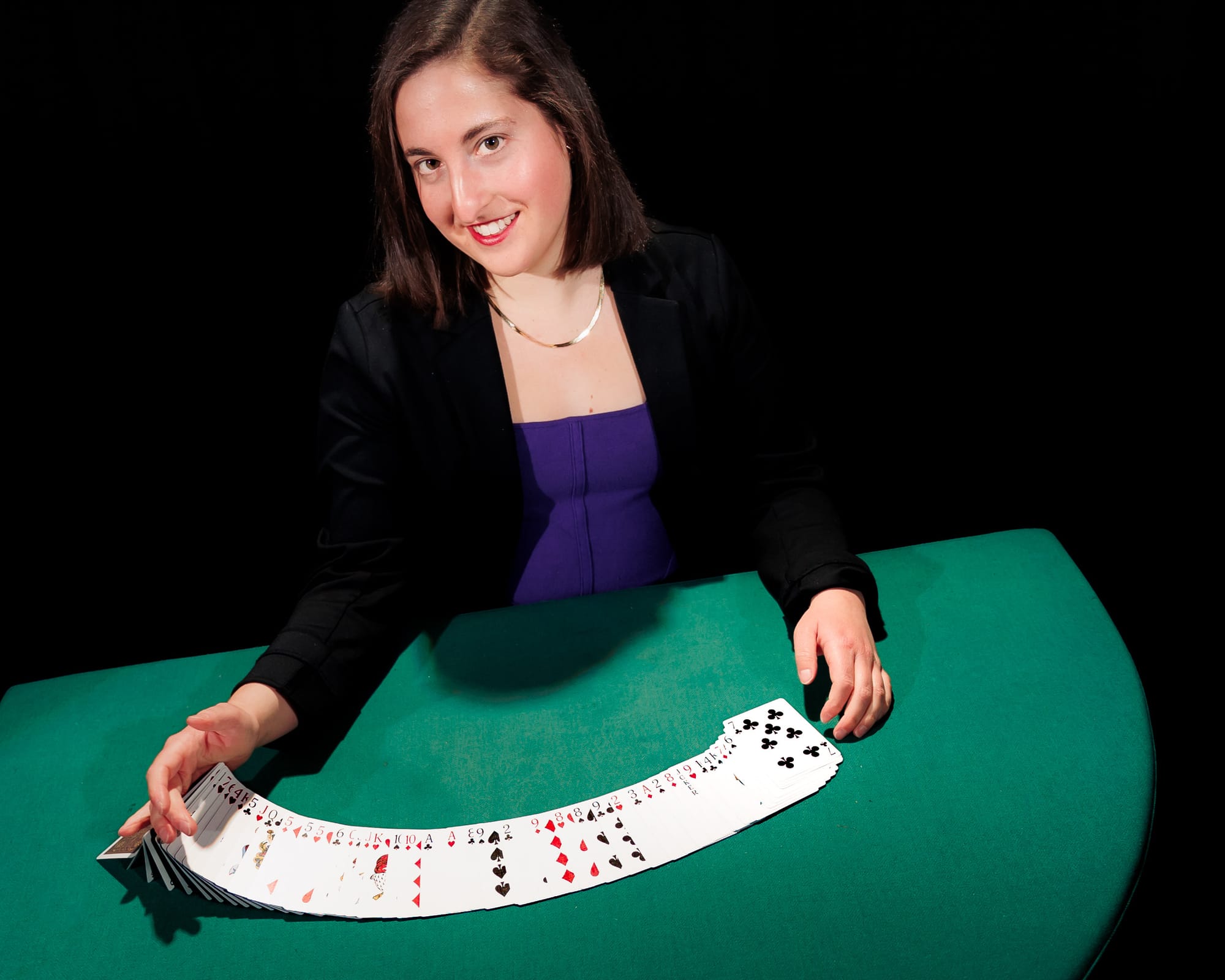Lupe Nielsen has been involved in magic for decades; you read Jeff Prace’s Best in Show feature about her craftsmanship in August. This year she was excited to be attending her first FISM, and we were excited that she agreed to write up its highlights and controversies. Her “Postcards from FISM” forms our first feature. We’ve also added Felice Ling’s great account of her Street Magic competition—which was a first at this year’s FISM. You’ll find her account on the pages of “Street Magic in Torino”—and you will also find another digital feature about how to prepare for such a competition on our new website: geniimagic.com.
Then, there’s our cover story about Jason Latimer’s fantastic Impossible Science project. He’s bringing magic—most important, magical thinking—to school kids and using those examples to teach science. At a time when science education is being hotly debated and dangerously neglected, Jason’s program has proven to be a ray of light (or maybe I should say, a blast from a laser) that’s been changing everything. Don’t miss Vanessa Armstrong’s story, “Jason Latimer’s Impossible Science.”
Finally, spend a few minutes with “The Madness of the Die Box,” a feature I worked on with my friends Steve Dick and Don Summers, with special thanks to the comedy magician Jim Piper. As I was writing it, I kept using the title, “The Trick That Ate Magic,” and although we settled on a slightly less apocalyptic title, you’ll get the idea. It’s a trick that came to represent much of 20th-century magic: the formulaic presentation, the guaranteed response from the audience, and the relentless tug from the magic dealers, pulling us all in an assured direction. Don supplied the pictures of unusual die boxes from his own collection. He told me that he had never actually counted, but he has hundreds of different styles. When we discussed photos of his die boxes, I told Don, “Start with the crazy ones,” and his photos just rolled in, one after another….

Over the last few issues, I’ve joked about coincidental connections that seem to appear in Genii, including the August issue when Spring Snakes suddenly were “a thing.” The problem with those sorts of coincidences is that you become aware they’re not just happening on the pages, but also happening in your head—the ouroboros: the snake consuming its own tail, the cycle that is omnipresent. So as September started to wrap up, I noticed a proofreading note from our associate editor, Vanessa Armstrong, who commented on “the ACAAN issue,” otherwise known as September.
And she’s right: ACAAN (Any Card at Any Number) appears in references and in spirit. Annanya George writes about understanding the medium of the trick and makes an observation about how “the odds of this happening” are so low that “this distinct and strange impossibility” makes it a classic. But he’s guilty of a classical layperson’s exaggeration. The actual statistics of the classic ACAAN are one in 52. That means that the trick is just the same as having a card named and finding it on top of the deck, or having a card named and finding it in an orange, or in your wallet. The addition of “give me the number in the pack, where it should appear” is a dazzling smokescreen suggesting statistics, but means almost nothing statistically. (To me, it’s a very Berglassian touch, indicative of David Berglas’ way of exploiting all of our misunderstandings in his brilliant presentations.)
Then, a few pages later in the magazine, Roberto Mansilla describes his stand-up presentation for ACAAN. Coincidentally, when I first met Roberto, he was performing this trick in a lecture in Argentina. My Spanish isn’t very good, but it was just good enough to allow me to follow his explanation, almost as amazing as his effect. I’m really pleased that it’s appearing in this month’s Genii. It’s worth going through the sequence and understanding how he’s making this trick happen in front of the audience.
Noah Levine pointed out how lucky we are to have another great “think a card” plot this month, with Jerry Sadowitz’s description of Douglas Cameron’s addition to Out of This World. It’s another one-in-52 mystery, here combined with the statistical juggernaut that is Paul Curry’s great, classic effect.
But of course, confirming our newly minted Genii theory of ouroboros, Vanessa’s news column, The Eye, contains an account from a recent academic study describing what spectators really think about “free choices” in a card trick. You’ll be surprised.
Keep reading: There’s a fair amount of Do-It-Yourself skills represented in these pages. Be sure to notice Richard Kaufman’s account of Jared Kopf’s great Psychometry routine, using four business cards. The handling is elegant and smart, and typical of its creator. Blake Vogt introduces you to a new creator, Hok, who adopts an “optical illusion” point of view with a simply made paper fake. Abby Segal contributes a fantastic new handling for a Coins to Glass routine, with her account of her attempts, misfires, and adjustments. She then writes up the instructions for making the apparatus—including her beautiful illustrations that make the trick look perfectly fun and adventurous. In her hands, it’s something of a miracle. You can learn more about Abby by watching this month’s Genii Speak video.

Recently, the actor Jason Alexander has been seen by Los Angeles audiences as Tevye in Fiddler on the Roof, and in a special guest appearance with the Improvised Shakespeare Company—a hilarious show that I saw at the Ford Theater. Somewhere, in the middle of his busy schedule, he stopped by Genii and answered some questions, discussing his interest in magic and his favorite effects. You’ll find him on the last page of this month’s issue.
John Gaughan is back to describe a beautiful—and maddeningly complicated—piece of German apparatus to make cards rise from a jumbo deck. It’s in “Chamber of Secrets.” Take a look at this month’s Genii Speak video. A few months ago, I promised an interview with John Gaughan about wood-turned magic props. I knew it would be a fascinating discussion with him, and I was right. If you ever held one of these fantastic turned pieces in your hands, and wondered about the craftsmanship behind them—John has fantastic insight about that work, based on his own experience at the lathe.
In 1937, Genii magazine offered a brief review for a new book on illusions, Jarrett Magic, to which editor William Larsen appended an even briefer review: “The book is definitely lousy.” As someone who has written about Jarrett’s important and revolutionary understanding of magic, I gave Larsen a hard time about this sentence. But I’ve come to admire his decisiveness. The length of the review was part of his review.
I notice that we still get comments about the overall length of our reviews, because readers suspect they must be insignificant. I can assure readers that “longer” doesn’t mean “literary” or even “important.” Overall, our goal is to offer the right review—the right perspective—for the product or book. Writing long essays about the current tricks is a good way for Genii to call attention to itself by dancing attendance on the dealers’ latest whims. Instead, we allow ourselves the freedom of saying what needs to be said, in the interest of fairness and honesty.
As we have been told, candidly by dealers, their business is about throughput. There’s a nonstop conveyor belt of new items that roll into your laptop. Their tricks are advertised with their own reviews, their own quotes, their own demonstrations, and their own prewritten praise. Dealers tell us they don’t need any Genii reviews; they can sell their own products perfectly well, thank you. But Genii reviews are neither ads nor press releases. We’ve already received snarls from dealers, who thought we’d unfairly criticized their latest offerings.
Believe me, as a Genii editor, I’ve felt a number of these tricks have deserved the Larsen treatment: “This trick is definitely lousy.” We won’t do that, of course. You’re owed more information and perspective. But don’t be fooled by the length of reviews. As Mark Twain once wrote to a friend, “I didn’t have time to write a short letter, so I wrote a long one instead.”

